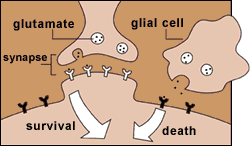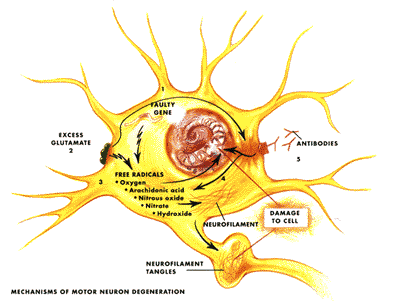















Jump to:
Possible Causes For Sporadic ALS
Types of FALS and Their Genes
The Role of Susceptibility Genes
Guamanian ALS - What Happened?
According to Dr. Chamberlain of the University of Washington's Neurology Department, "ALS has many different causes, and so it is probably fair to say that ALS refers to several different diseases that all affect people in the same way." Indeed, there is not only one probable cause of the disease, but many that can vary from person to person. A growing theory is that a combination of a person's genes in addition to one or more environmental triggers can result in ALS.
 Excitotoxicity: The condition where excess glutamate clogs the synapses of motor neurons in the brain and spinal cord, leading to a build-up of calcium; too much calcium leads to a blocked transmission of messages resulting in motor neuron death. In return, as motor neurons die, more glutamate is released, creating a cycle of destruction. A side note to excitotoxicity is the role of glia cells, responsible for clearing the excess neurotransmitter. Problems with the glia cells may cause or otherwise increase the rate of excitotoxicity. Another possibility is that the excess glutamate is actually damaging the glia cells, causing them to malfunction and let excitotoxicity take its course.
Excitotoxicity: The condition where excess glutamate clogs the synapses of motor neurons in the brain and spinal cord, leading to a build-up of calcium; too much calcium leads to a blocked transmission of messages resulting in motor neuron death. In return, as motor neurons die, more glutamate is released, creating a cycle of destruction. A side note to excitotoxicity is the role of glia cells, responsible for clearing the excess neurotransmitter. Problems with the glia cells may cause or otherwise increase the rate of excitotoxicity. Another possibility is that the excess glutamate is actually damaging the glia cells, causing them to malfunction and let excitotoxicity take its course.
Oxidative Stress: The process where free radicals, molecules with an uneven number of electrons, attack cellular structures. In a normal person, the body is able to contain most free radicals, whereas in an ALS-afflicted person, free radicals accumulate to high levels in the brain and spinal cord, resulting in motor neuron damage.
Mitochondrial Abnormalities: Mitochondria are the powerhouses of cells, providing them with the energy they need. Mitochondria have their own set of DNA, which is packed in rings that are not well protected against damage, such as the ones accquired from free radicals within the mitochondria. Damaging mitochondrial DNA may damage the mitochondria itself, leading to a reduced function of the cell because of the absence of needed energy.
Neurofilament Buildup: Neurofilaments are proteins that are the "scaffolding" of a cell--they are the parts that give a cell its shape. Normally, neurofilaments clump along the axons of a motor neuron, providing for easy transport of messages. In ALS, neurofilaments clump near the cell body or they tangle in the axon. Either way, the flow of messages is blockaded.
Apoptosis: Programmed cell death (cell suicide) is a natural part of a cell's life and happens to all cells in our body to some extent. Scientists are wondering if maybe something is triggering apoptosis to happen earlier than it should be in those with ALS.
Infectious Agents: Viruses, microorganisms, and prions may play a role in damaging nerve cells, but no specific infectious triggers have yet been found. An interesting note are the prions, which act like viruses, but can turn good proteins into toxic molecules that damage motor neurons.
Autoimmunity: The body turns against itself and attacks its own cells.
It has been believed before that trauma to the brain or spinal cord, physical activity, radiation, or electrical shock could cause ALS. Studies have shown that this is probably not the case. Besides the possible causes listed above, there may be environmental factors such as exposure to lead or pesticides, but studies are not definite as the results differ from each another. The fact that there is a high incidence of ALS among Gulf War veterans adds to the theory that one's environment plays a role, and in this case--being exposed to something while in service during the war. Having abnormal chromosomes may be a risk factor for developing ALS, for shown in a recent German study involving 85 patients with sporadic ALS, 6% of the patients had chromosomal rearrangements containing genes that played a crucial roles in motor neurons.

Although there are some loci (places where genes are found on a chromosome; can be wide ranging for uncertainty in exact location) identified that are linked to various types of FALS, only two genes have been found to play a direct role--the SOD1 gene and the alsin gene. With today's advances in biotechnology leading the way, it is safe to say that more genes involved in ALS will soon be discovered.
 ALS1: ALS1 accounts for about 20% of all FALS cases, resulting from mutations in the SOD1 gene located on locus 21q22.11 (chromosome 21, long arm q, region 22, band 11). SOD1 stands for superoxide dismutase, and the enzyme that is coded by this gene changes the superoxide radical O2- to oxygen and hydrogen peroxide molecules. Over 100 different mutations have been discovered in those with ALS1, primarily missense mutations, which occur when a codon gets changed for the wrong amino acid. ASL1 is inherited mostly in an autosomal-dominant manner, but there is one mutation, the D90A, that causes ALS1 in an autosomal-recessive manner. Not all people who have mutations in the SOD1 gene end up developing ALS; conversely, a small number of people who have sporadic ALS are found to have SOD1 mutations. The average age of onset for ALS1 is 46 years old.
ALS1: ALS1 accounts for about 20% of all FALS cases, resulting from mutations in the SOD1 gene located on locus 21q22.11 (chromosome 21, long arm q, region 22, band 11). SOD1 stands for superoxide dismutase, and the enzyme that is coded by this gene changes the superoxide radical O2- to oxygen and hydrogen peroxide molecules. Over 100 different mutations have been discovered in those with ALS1, primarily missense mutations, which occur when a codon gets changed for the wrong amino acid. ASL1 is inherited mostly in an autosomal-dominant manner, but there is one mutation, the D90A, that causes ALS1 in an autosomal-recessive manner. Not all people who have mutations in the SOD1 gene end up developing ALS; conversely, a small number of people who have sporadic ALS are found to have SOD1 mutations. The average age of onset for ALS1 is 46 years old.
For the gene sequence of SOD1, click here.
ALS2: The second and only other gene discovered to cause ALS is the alsin gene, located on locus 2q33-34. Alsin is believed to be involved in neuronal microtubule assembly, membrane organization, and trafficking of nutrients. Appearing in Tunisian and Kuwaiti families, onset is usually between the ages of 3-23 and survival is from 15-20 years.
ALS3: ALS3 is the name given to all dominant cases of FALS that have not yet been assigned a locus.
ALS4: The unknown gene for ALS4 has been narrowed down to locus 9q34, and the disease has already been found in an extended family. Onset is juvenile, but progression is slow so life is not much affected until middle age. The inheritance is autosomal-dominant.
ALS5: Much like ALS2, ALS5 is autosomal-recessive, but has a locus of 15q15-q22. Onset is between the ages of 8-18, and is primarily seen in people of North African, South Asian, and European descent.
ALS6: The gene for this has not yet been determined, but ALS6 has a locus of 18q21 and is clinically similar to sporadic ALS. It is inherited autosomal-dominantly.
X-Linked ALS: X-linked ALS has a locus of Xp11-q12 and is clinically similar to sporadic ALS. Males with X-linked ALS experience about a 20 year earlier onset than their affected female relatives. X-linked ALS is dominant.
There are some susceptibility genes under current study, thought to play a more indirect role in that they can cause ALS when present with other genetic or environmental factors. The following are a couple of genes that recent studies had been done on, but they are by no means the complete listing.
Dynactin: The dynactin gene codes for a protein that moves nutrients and neurotrophic factors down the axon of neurons, and defects in this gene might lead to poor axonal transport. Without sufficient neurotrophic factors, motor neurons have less resistance to things like oxidative stress.
VEGF: VEGF stands for vascular endothelial growth factor, and is a protein of blood vessels. According to a European study, having variations in the gene can double a person's risk of contracting ALS. Mice bred missing the VEGF gene and lacking a functional SOD1 gene, died earlier than mice just missing VEGF or SOD1.
To this day, scientists cannot be absolutely sure what caused the epidemic to break out in the 1950s. The Chamorro people's diet was closely studied, since they frequently ingested cycasin from local cycad plants, which were poisonous. Ingesting large amounts of cycasin reduces DNA repair in neurons and increases excitotoxicity. Also, mineral imbalances such as low amounts of calcium and magnesium, and high amounts of aluminum and iron could be blamed for their nerve deaths.